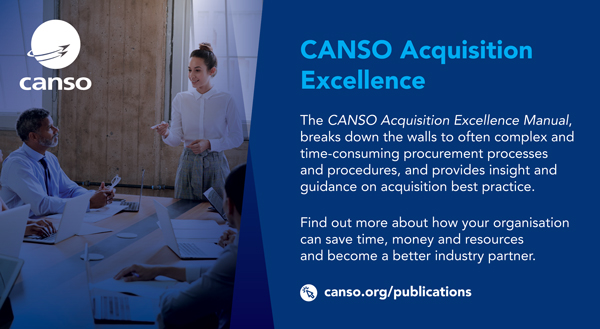Airspace Q3 2019 – Assessing potential suppliers
In the third of a series of articles for Airspace on best practice in procurement, Fiona Thompson, Operations Director, Park Air Systems, outlines the right way to carry out a successful supplier assessment.

Stakeholders involved in supplier selection will undoubtedly ask: how do I ensure that the supplier I choose will fulfil my organisation’s needs?
Supplier selection is a business process undertaken to evaluate suppliers. By following a few key steps, you can reduce the risk of choosing the wrong supplier.
External data
Assessing suppliers is an information gathering exercise that should involve a myriad of stakeholders within the organisation and also the evaluation of independent external data.
An assessment is comprised of both formal and informal processes. The informal part of an assessment will usually be done prior to the release of any formal process, such as a request for information or a request for proposals, but it can also run in parallel.
The informal part of an assessment should first include discussions with any internal stakeholders who have previously used this supplier. Their feedback will be invaluable as they will have real life experience with the capabilities and shortcomings on delivering within the organisation.
Experiences of other companies can also be extremely valuable. Reaching out to other companies as to their experience with a particular supplier can provide you with a different perspective than those of your internal stakeholders.
Researching the financial viability of a supplier should also be part of your review. A financial assessment system can easily be accessed to ensure that the supplier has a sound financial footing.
Formal criteria
The formal part of an assessment should contain an evaluation of the following key areas.
Capability: Does the supplier have the technical capability to produce the product or perform the service you need? This assessment can be done by questioning specifically how the supplier plans to deliver the goods or services and demanding a detailed account of key steps. Requesting evidence of previous implementations within the marketplace is also recommended.
Capacity: Does the supplier have the resources required – in people and equipment – to satisfy their current order backlog, their future forecast and to fulfil your requirements? This assessment can be more difficult. Requesting the supplier to identify the number of personnel or hours tied to key steps in your evaluation can help. Key personnel clauses in your terms and conditions can also ensure that the initial ‘A Team’ that is usually presented during an evaluation process is kept on for the life of a project.
On-time delivery: Does the supplier have an acceptable on-time delivery record, and does its lead-times meet the requirements of your organisation? This is where your informal investigations can prove useful but within the formal process you can include penalty clauses or liquidated damages for late delivery. Negotiations and discussions with the supplier around these obligations will be telling in how comfortable they are with the timelines.
Quality: Does the supplier have an adequate management system – such as ISO 90001 – or other controls and standards to demonstrate that it can adequately manage its quality?
Pricing: Does the pricing of the products or services reflect the value of the product?
Business continuity plans/disaster recovery: Does the business have a robust, well-documented business continuity plan in the event of a disruption?
Cybersecurity: Does the supplier have sufficient protection from a cyberattack that would disrupt its everyday business continuity?
Information security: Does the company understand its obligation regarding the control of personal data?
Terms and Conditions: Does the company have acceptable terms and conditions, including payment terms, that can be agreed by both parties?
Safety and ethics: Does the supplier demonstrate both a safe and ethical working environment? This evaluation can include whether the supplier has a code of conduct that has become a best practice within an organisation.
Social Responsibility: Does the business show social/corporate responsibilities when conducting its business, including such areas as the environment and health and safety?
Once the above areas have been assessed, risks can be analysed. Having all this data, as well as the data on the product/service in a weighted format will allow you to make an informed decision on which is the most suitable supplier for your business and for the requirement you have.
Other considerations
Sometimes suppliers will be selected out of convenience or necessity due to the speed with which the product or service is required. As long as the risks to the business are low and the product or service being procured is not overly complex, this can be acceptable. However, to ensure that costs are as competitive as possible, this is not recommended as a best practice.
There may also be instances of stakeholders requesting the use a particular supplier. This should not stop the business from following their normal selection process. If the vendors are found to be unsatisfactory, then this should be discussed with the customer and a solution sought.
Performing the assessment
A supplier assessment is usually performed by the supply chain/procurement functions in conjunction with internal stakeholders, such as engineering or operations. You may wish to also include quality assurance or related teams. The advice of legal counsel, insurance and tax personnel can also be sought to evaluate the global risk.
Should urgent business requirements mean the selection process needs to be expedited, the risk to the business should be assessed and mitigation plans produced to ensure all risk is kept to a minimum. The advantages of approving the supplier rapidly must outweigh the risk of not following the process.
Once approved, the supplier’s performance against the above criteria should be monitored by the relevant parties quarterly, and their records updated accordingly. Relevant parties usually include members from the purchasing, quality, engineering and technical departments although others may be applicable depending on the product or service.
The next article in this series will examine best practice in working collaboratively.




